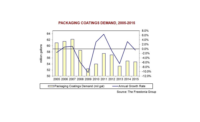Food and pharma demand for green packaging transforms the flexible packaging coatings market
The flexible packaging coatings market is set to witness robust growth due to the increasing need to enhance the shelf life of products in the North American food and pharmaceutical industries. Packaging coatings for the food segment holds the largest market trailed by the pharmaceutical sector. The latter trails as a result of the stringent regulations and long duration taken for product launch, making pharmaceuticals a less ventured sector. Rising consumer preference for lightweight products and the need to improve the quality of packaged contents are opening new avenues for market expansion of flexible packaging coatings.
Recent analysis from Frost & Sullivan (frost.com), North American Flexible Packaging Coatings for the Food and the Pharmaceuticals Markets (http://www.frost.com/nf82), finds that the market earned revenues of $1.44 billion in 2014 and estimates this to reach $1.97 billion in 2021. The study covers heat seal coatings, cold seal coatings, barrier coatings, co-extrusion primers and functional additives.
The enhanced efficiency, recyclability and composability of sustainable coatings will make green packaging a feasible option for North American market participants. Higher adaptation of sustainable coatings is observed throughout the forecast period. Thus, in place of solvent-based resins, formulators are turning to bio-based alternatives to develop flexible packaging coating solutions.
“Approximately 50% of the US population aged between 18 and 35 prefers to purchase products with labels that declare them to be environment friendly,” says Frost & Sullivan visionary science team leader Nandhini Rajagopal. “As this section of the population is willing to pay a premium for products with recyclable packaging.”
The price value offered by packaging coatings has encouraged cost conscious integrated packaging providers and pure players to adapt the product. Technological innovations in flexible packaging coatings such as ultra-thin coatings using nanotechnology and bio-based solutions offer significant growth opportunities. These coatings provide superior barrier protection as well as help in lowering the packaging layers, thus providing comprehensive quality and convenience.
“Evidently, novel flexible packaging coatings with an attractive price-performance ratio and innovative customer support services are key differentiators in the highly competitive and fragmented market,” summed up Rajagopal. “With the growing presence of participants with specialized product development capabilities and the need for heavy investments in R&D set-ups for innovation, tier 1 participants will enjoy considerable opportunities for mergers and acquisitions.”
North American Flexible Packaging Coatings for the Food and the Pharmaceuticals Markets is part of the Chemicals & Materials Growth Partnership Service program. Frost & Sullivan’s related studies include: Global Process and Production Chemicals for Electronics, Growth Opportunity Analysis of the Global Tapes Market, Global Polyols Market, Wood Coatings Market in NA and Europe, and Investment Analysis of the North American Packaging Industry and Trends in Western European Bioplastics in Packaging Market. All studies included in subscriptions provide detailed market opportunities and industry trends evaluated following extensive interviews with market participants.
Looking for a reprint of this article?
From high-res PDFs to custom plaques, order your copy today!





